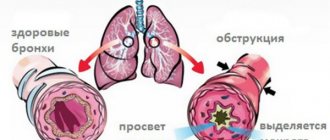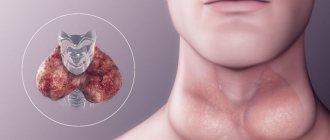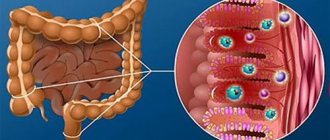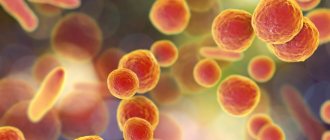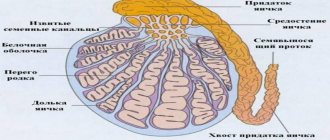Leukopenia
Leukopenia (neutropenia, leukocytopenia) is a syndrome characterized by a decrease in the level of leukocytes in the blood (less than 1.5 × 109 / l). The borderline manifestation of leukopenia is agranulocytosis, which is a condition in which there is almost no white blood cells in the blood. This form of the pathological process is rarely diagnosed. Death rates as a result of leukopenia of varying complexity range from 5-40%.
Causes of leukopenia
Leukopenia is a polyetiological condition that can be a primary pathology or a complication of other diseases. When unfavorable factors affect the part of the bone marrow that produces white blood cells, massive destruction of young blood cells occurs, as a result of which the formation of mature leukocytes stops.
A common cause of neutropenia is the use of chemotherapy drugs and radiotherapy prescribed for cancer.
Leukopenia can also be caused by the following pathological processes:
- rheumatoid arthritis and renal failure, the treatment of which involves the use of drugs that provoke the development of neutropenia,
- congenital genetic abnormalities,
- the use of chemotherapy drugs for blood cancer and other malignant tumors,
- damage to bone marrow tissue, which is responsible for the production of blood cells, by a malignant tumor,
- failure of metabolic processes, which are accompanied by a lack of folic acid, copper, B vitamins,
- prolonged contact with harmful chemicals, leading to disruption of the production of white blood cells,
- tuberculosis,
- various infections (hepatitis, rubella, etc.).
Symptoms of leukopenia
The pathological condition does not manifest itself with any special clinical symptoms, so there are no signs of neutropenia. The first symptoms appear when infectious or bacterial complications occur, the likelihood of which increases with increasing time of leukopenia. Also, the risk of complications increases as the pathology develops.
The first symptom of an infection caused by neutropenia is a sharp increase in temperature; ulcerations on the mucous membranes of the mouth, pain when swallowing, hoarseness, and bleeding gums may also be observed.
The criterion for diagnosing neutropenia in children is considered to be a decrease in the number of leukocytes to a level below 4.5 × 109/l. A common cause of this syndrome in children is considered to be infections, including measles, mumps, influenza, etc. Leukopenia can also occur as a side effect of certain medications, including antibiotics, sulfonamides, and antihistamines.
Diagnosis of leukopenia
If leukopenia is suspected, a number of diagnostic tests are prescribed, including the following:
- laboratory blood test, which allows you to count the number of white blood cells and create a leukocyte formula,
- bone marrow puncture allows us to determine the causes of the syndrome,
- blood test for immature blood cells,
- blood tests for antinuclear and antigranulocyte antibodies,
- blood chemistry.
Clinical manifestations
At the initial stage of the disease, obvious signs of leukopenia are almost always absent. The patient may experience headaches, weakness, and dizziness. As a rule, no one pays attention to these signals, but the clinical picture continues to change rapidly at this time. Against the background of a weakened body, infection often occurs, which is accompanied by:
- migraines;
- fever;
- chills;
- increased heart rate.
Quite often, lesions of the gastrointestinal mucosa appear in the form of numerous ulcers and erosions, blood infections, and inflammatory processes in the oral cavity.
Attention should also be paid to the characteristics of the course of the disease. All infectious processes in the body are several times more severe. For example, slight irritation on the skin can lead to phlegmon. Very often after chemotherapy, damage to the spleen, liver and intestinal cells is observed. Any infection in this case becomes life-threatening for the patient. Thanks to a blood test, as a rule, not only leukopenia is detected. Thrombocytopenia, for example, almost always inevitably develops against the background of suppressed platelet production.
Treatment of leukopenia
The advanced form of the syndrome does not require special therapy - treatment tactics are aimed at preventing possible infectious complications and eliminating the cause of the pathological process. Bed rest in absolutely sterile conditions, special nutrition, and hormonal therapy are also recommended. An important condition for the treatment of advanced forms of neutropenia is the transfusion of leukocyte mass and stimulation of leukopoiesis.
If autoimmune agranulocytosis or aplastic anemia is detected, immunosuppressive treatment is carried out. Medications are prescribed individually in each clinical case. If neutropenia is a side effect of taking any medications, immediate discontinuation is recommended. When the pathology is combined with a lack of folic acid or vitamin B12, medications containing these elements are prescribed.
An important condition for the treatment and prevention of leukopenia in cancer, which can be caused by the use of chemotherapy drugs, are colony-stimulating factors (G-CSF and GM-CSF), the action of which is aimed at increasing the number of macrophages and neutrophils in the peripheral blood, as well as stimulating their anti-infective properties.
How to treat?
First of all, in order to increase the level of leukocytes, you need to clarify the exact reason for their decrease. Often additional examination methods may be required. When an accurate diagnosis is established, etiotropic therapy is prescribed, which is aimed at eliminating the very cause of the pathology, for example:
- If these are signs of group B vitamin deficiency, medications containing these substances are prescribed and the diet is adjusted.
- If leukopenia is caused by diabetes, then medications are used to maintain blood sugar levels and normalize the functioning of the pancreas.
- For HIV infection, lifelong ART therapy is prescribed. The viral load (the number of copies of the virus) drops, and the immune system recovers on its own.
Among the common medications, immunostimulants, immunomodulators (restore the functioning of the immune system) and immunocorrectors (remove damaged parts of the immune system) are used:
- recombinant – interferons alpha, beta, gamma;
- colony-stimulating factors – Filgrastil, Lenograstim;
- fungal and microbial origin - Bronchomunal, IRS-19, Likopid;
- animal origin – Myelopid, Thymogen, Timalin;
- interleukins – interleukocyte mediators (Roncoleukin);
- other active substances - vitamins, adaptogens (eleutherococcus, ginseng, etc.);
- of plant origin - products containing echinacea (Immunal, Ikhinacin, Ikhingin).
[adsense3]
In addition, you need to independently help the body increase white blood cells; to do this, you should eat a balanced diet: eat more vegetables and fruits, protein foods, and reduce fat intake. The diet should contain meat, legumes, dairy products, cereals, and walnuts. It is not recommended to eat fatty fish and meat. Do not use spices and seasonings when preparing dishes.
In addition to drug treatment, you can increase your white blood cell level at home. Traditional recipes for leukopenia should be used as an auxiliary therapy, but not as the main one.
What is leukopenia?
A decrease in the number of leukocytes (white blood cells) is called leukopenia. It comes in two types: functional and organic.
Functional develops with:
- typhoid fever;
- viral diseases;
- systematic fasting;
- taking amidopyrine, sulfonamides;
- influence of ionizing penetrating radiation (radiation).
Organic leukopenia is a consequence of acute leukemia or aplastic anemia. Leukemia is an oncological disease whose development begins in the bone marrow. Cancer cells replace the structure of the bone marrow, as a result, healthy blood cells are not produced, so white blood cell counts drop. Aplastic anemia is a rare disease of the hematopoietic system, in which the hematopoietic function of the bone marrow is inhibited.
Leukopenia is mistakenly identified with agranulocytosis, claiming that they are the same thing. To think so is a delusion. Leukopenia itself is not an independent disease. And in some cases, a moderate decrease in leukocytes is the physiological norm for an individual person.
Agranulocytosis is an obligatory pathological consequence of chemotherapy, and severe leukopenia is its main symptom. Why is this happening?
The effect of chemotherapy is aimed at destroying rapidly dividing cells. These are cancer cells, as well as healthy cells of the body: cells of hair, nails, mucous membranes, neutrophils (a type of leukocytes, the content of which in the blood is up to 70%, their lifespan is 1 ─ 3 days). Once in the body, chemicals are unable to distinguish healthy cells from cancerous ones and therefore destroy them all. And if in the case of hair, baldness is not a life-threatening symptom, then the destruction of leukocytes on such a scale causes severe leukopenia, destroying the immune system. The result is an absolute lack of body resistance.
Possible consequences
Modern medicine distinguishes various types of leukopenia, the classification of which primarily depends on factors that contribute to a sharp decrease in the number of white blood cells. However, regardless of the type of disease, all necessary measures should be immediately taken to combat it. If treatment is not prescribed in a timely manner, there is a high probability of complications that may be life-threatening for the patient.
Many people, having seen a blood test, do not know what leukopenia actually threatens. Most believe that negative consequences can only be caused by those diseases that provoked a sharp decrease in white blood cells. In fact, this opinion is wrong. Leukopenia weakens the body's protective functions. The lack of excellent immunity often leads to the fact that the presence of the most banal bacterial infection in the body can become an emergency. Moreover, with leukopenia, the risk of acquiring a tumor disease almost doubles. Also possible consequences of this pathological condition include agranulocytosis and aleukia (bone marrow damage).
How is leukopenia different from blood cancer?
Blood cancer is a malignant disease of the blood system. And leukopenia is a reactive state of the body in response to the influence of external or internal factors.
If with leukopenia there are only changes in the number of certain structures of leukocytes (lymphocytes, neutrophils, monocytes, platelets), then with leukemia the very quality and functionality of blood cells is impaired, up to their destruction.
Normally, the bone marrow produces stem cells, which subsequently divide (differentiate) and enter the bloodstream already functionally developed (leukocytes, red blood cells). With leukemia, the following changes occur:
- Stem cells, the precursors of leukocytes, do not follow the path of normal development, degenerate and become malignant.
- Newly formed atypical cells suppress the normal development of stem cells around them.
- Gradually, the bone marrow completely replaces physiological blood cells with cancerous ones, and the bone marrow loses the ability to produce white blood cells and other blood cells.
- Young, aggressive cancer cells enter the bloodstream and spread throughout the body.
The relationship between leukopenia and leukemia
Constant leukopenia, especially against the background of frequent viral infections, makes you think. A low white blood cell count may be a consequence of a disease, including leukemia. But in some cases, on the contrary, leukopenia contributes to the development of diseases. A downward shift in leukocyte counts doubles the risk of cancer. The danger is that if you do not pay attention to this in a timely manner, you may miss the onset of the development of blood cancer (leukemia or acute leukemia).
Important!
When assessing a clinical blood test, leukopenia is analyzed in two directions: as a consequence of an existing pathological process in the body, and as a harbinger of a possible future disease.
With leukopenia, the number of white cells decreases, their protective activity slows down significantly. This leads to an overload of the immune system. As a result, atypical (cancer) cells are activated.
There is an opinion that physiological (acquired or congenital) leukopenia can serve as an impetus for the development of leukemia. However, this version is considered at the level of hypothesis.
Leukopenia in itself is not a terrible diagnosis, but only serves as a signal to pay attention to the state of your health.
How to prevent the development of leukopenia?
Fortunately, leukopenia is not one of the most common disorders . However, you should know how to prevent the development of the disease, because it usually occurs in a very severe form and in some cases is dangerous for human life.
The likelihood of developing leukopenia can be significantly reduced by complying with the following requirements:
- Avoid exposure to radiation whenever possible. When undergoing X-rays or fluorography, preference should be given to medical centers that have new generation equipment that ensures minimal exposure to radiation on the body;
- Do not prescribe medications to yourself, especially hormonal, psychotropic, and antibiotics. With their uncontrolled and long-term use, a pathological change in the number of leukocytes in the blood is possible, and it will subsequently be very difficult to normalize the condition;
- do not allow a sharp decrease in body weight, “starvation” diets with maximum calorie restriction and the exclusion of many foods. In this case, a significant deficiency of minerals and vitamins may occur, fraught with changes in blood composition;
- observe hygiene requirements in order to avoid infection with some dangerous viral infections transmitted mainly through contact and household contact.
If it was still not possible to avoid the disease, the treatment prognosis will be more favorable if you consult a doctor in a timely manner . A patient suffering from leukopenia, in addition to performing prescribed activities, must exercise maximum caution in daily activities.
The patient is prohibited from drinking raw water, eating insufficiently washed fruits or vegetables, or unpasteurized milk. Such measures are required in order to avoid possible infection with bacterial and other ailments, because the body of a person suffering from leukopenia is not sufficiently protected from the ingress of bacteria from the outside.
For the same reason, when visiting public places, you must wear a protective mask over your mouth and nose and avoid any contact with infected people.
Important ! If your body temperature rises or your condition generally worsens, you should immediately go to the hospital, because leukopenia is characterized by a very rapid increase in symptoms. As a rule, in this case the patient will require urgent hospitalization.
Careful monitoring of your health will help you protect yourself fairly reliably from leukopenia. This insidious disease is caused by a sudden malfunction of one or another important system of the body, so a healthy lifestyle is a panacea for many diseases, including diseases of the hematopoietic system.
What is leukopenia and how is it different from blood cancer?
The immune system of the human body is a barrier against infectious and foreign substances and agents. Its action is aimed at maintaining the stability of cellular genetics - antitumor protection.
Leukocytes, which originate in the spleen, bone marrow, lymph nodes and are contained in the blood, protect the body from infectious manifestations. But a violation of stability in the fight against harmful organisms and foreign agents results in the loss of leukocytes.
A number of drugs https://s-pharma.net/protivoopuholevye have an antitumor effect. Leukopenia is characterized by a loss of leukocyte volume: below 4 thousand in 1 mm3 of blood.
What diet do doctors prescribe?
For some time, even if successful treatment has been completed, you need to monitor the general condition of the body, for this purpose they make adjustments and select acceptable food. You should remove the consumption of fatty foods from the menu, eat often and not much.
The diet must include ingredients with a certain ability:
- ionizing radiation is reduced by green herbs in the form of parsley, dill, basil
- dairy products, hard cheeses increase the number of leukocytes
- seafood, red caviar increase hemoglobin levels
- cabbage, legumes strengthen the immune system
- dietary poultry or rabbit meat saturates the body without increasing the calorie content of food
To normalize blood cells, all the elements that make up the fluid important for the human body, you need a properly balanced diet rich in proteins, with preference given to lean meat and fish. You need to avoid spicy and fried foods and use enough fermented milk products in your diet.
Dr. Komarovsky talks about children's immunity in the video:
Are leukopenia and blood cancer the same thing?
A decrease in leukocytes has the following reasons:
viral and bacterial complications of current infectious diseases;
taking specific groups of medications (a certain range of antibiotics, cytostatic drugs, antidepressants, sulfonamides, etc.);
contact with certain types of chemicals (benzene, insecticides, hair dye, arsenic, etc.);
hormonal imbalance, acute lack of mineral and vitamin resources necessary for the reproduction of white cells, poor nutrition;
damage to cerebrospinal fluid cells after irradiation or exceeding background radiation levels;
In patients diagnosed with blood cancer, cases of metastases to the bone marrow are observed, leading to the loss of the required number of leukocytes.
Hemoblastosis or leukemia is an oncological disease that differs from leukopenia in the uncontrolled growth of tissue formed from hematopoietic cells. When cancer cells damage the bone marrow, the proliferation of immature leukocytes - leukemia cells - starts.
Features of the increase in immature leukocytes:
- complications of diseases of viral etiology;
- exposure to chemical poisons through the respiratory or digestive systems, as well as through direct contact;
- genetic factor;
- unfavorable radiation environment or exposure;
- taking certain therapeutic drugs (for example, stimulating erythropoiesis);
- metabolic disorder.
Thus, we conclude that an increase in the number of leukocytes and a steady decrease in their number are different courses of diametrically opposed diseases with equally pronounced cause-and-effect relationships. An abnormal number of leukemia cells helps in making the correct diagnosis.
Prevention and prognosis
Very often, leukopenia develops after cancer. After chemotherapy, treatment and prevention of this disease primarily imply precise selection of drug dosages. It is important to note that this depends not only on the experience of doctors, but also on the capabilities of specialized devices. That is why radiation therapy uses the most targeted effects. Mortality in the case of leukopenia in cancer patients does not exceed 30% of all cases.
It is important to pay special attention to an individual approach in treating patients in clinics. When prescribing certain drugs, the doctor must take into account the presence of intolerance to certain components, drug compatibility, and concomitant ailments. Here, a special role belongs to self-treatment and following the advice of loved ones. Any therapy should be prescribed only after a diagnostic examination, as well as consultation with a specialist.
In this article, we have described in as much detail as possible what leukopenia is. The causes of this disease can be very different, from a lack of certain vitamins to serious damage to the bone marrow. In any case, only competent therapy can help in the fight against this disease. Be healthy!
How is leukopenia different from blood cancer?
There are no typical symptoms with a decrease in leukocytes. Suspicions point to signs of infection: something that causes an increase in body temperature, fever, increased heart rate.
There is also an asymptomatic course of the disease, without external signs and suppressed effects on the patient. The analyzes performed can show the following results:
- leukocytes are moderately reduced;
- the functionality of leukocytes is not impaired;
- absence of pathologies in the bone marrow;
- the integrity of myelopoiesis (formation of blood elements in the bone marrow body) is preserved;
- the formation of red blood cells and platelets is not impaired.
The results obtained indicate that the body has diseases not related to blood, but accompanied by leukopenia: cholecystitis, thyrotoxicosis, gastritis, etc.
This pathology leaves a significant mark: the immune system takes the main blow, its protective layers deteriorate. If an infection enters the body, its defenses will be destroyed, and the patient will have to see a doctor, even if he is in satisfactory condition.
When and under what conditions does leukopenia turn into blood cancer?
The risk of low white blood cells carries the risk of AIDS or blood cancer.
Neutropenia is a decrease in the number of blood cells produced in the bone marrow. A decrease in the number of neutrophils (a type of white blood cell) weakens the immune system. In acute leukemia, mitosis (growth) of cancer cells occurs to the detriment of the development of non-pathological cells, which characterizes neutropenia.
Malignant tissues form metastases in the skeletal bones, where they infiltrate the bone marrow (leakage of liquids through solids) and suppress the production of blood cells without pathology. This confirms that neutropenia may be a sign of advanced cancer.
Patients with leukemia are characterized by the presence of leukopenia, the presence of which is caused by the breakdown of leukocytes due to obstruction of functional qualities.
The results of studying the functional qualities of leukocytes in leukemia confirm extensive disturbances of intracellular metabolism in such patients. These studies were typically conducted in patients with leukemic forms of leukemia.
Perhaps the decrease in the number of blood cells is explained by peculiar disturbances in the mechanisms that synthesize the outflow of leukocytes from the bone marrow into the blood.
To summarize, we understand: blood cancer and leukopenia are different diseases that have made a hole in the immune system.
The spleen, lymph nodes, bone marrow, thymus gland and other components of the body’s protective barrier are the starting points for obtaining a biopsy.
This analysis will help identify the root cause of the disease and choose treatment.
Pathogenetic mechanisms
- White bodies are classified as follows: they are divided into agranulocytes in the blood and granulocytes. Agranulocytes are divided into lymphocytes and monocytes, granulocytes - basophils, eosinophils, neutrophils.
- The white cell mechanism is disrupted. Leukocyte growth experiences various pathological influences. In this regard, there are many reasons that cause the decline in the formation of white blood cells.
- The second is severe damage to leukocytes. This variant of leukopenia occurs very rarely. Anti-leukocyte antibodies in the blood destroy white cells. The destruction of white bodies is also caused by large ranges of radiation.
- The mechanism of redistribution leukopenia, which occurs as a result of stressful conditions, physical exertion on muscles, due to stagnation of leukocytes. In this case, white cells do not leave the blood completely and remain in the vessels of the muscles, lungs, and kidneys.
- Another pathogenetic mechanism of leukopenia in a child is too much loss of mesh tissue. Occurs with burns of large areas of the body, suppuration, and disruption of the integrity of the lymphatic vessels.
- Blood thinning. This is a rare type of disease. It is a consequence of infusion therapy.
Photo of leukocyte
Leukopenia
Leukopenia (neutropenia, leukocytopenia) is a syndrome characterized by a decrease in the level of leukocytes in the blood (less than 1.5 × 109 / l). The borderline manifestation of leukopenia is agranulocytosis, which is a condition in which there is almost no white blood cells in the blood. This form of the pathological process is rarely diagnosed. Death rates as a result of leukopenia of varying complexity range from 5-40%.
Causes of leukopenia
Leukopenia is a polyetiological condition that can be a primary pathology or a complication of other diseases. When unfavorable factors affect the part of the bone marrow that produces white blood cells, massive destruction of young blood cells occurs, as a result of which the formation of mature leukocytes stops.
How dangerous is this disease?
Persistent leukopenia, according to doctors, leads to a decrease in immunity and a simultaneous increase in sensitivity to many infections and cancer, which often leads to death. The extreme manifestations of the disease are the following: agranulocytosis, neutropenia and aleukia. In this case, the body almost completely stops producing certain types of leukocytes.
Treatment of leukopenia
The advanced form of the syndrome does not require special therapy - treatment tactics are aimed at preventing possible infectious complications and eliminating the cause of the pathological process. Bed rest in absolutely sterile conditions, special nutrition, and hormonal therapy are also recommended. An important condition for the treatment of advanced forms of neutropenia is the transfusion of leukocyte mass and stimulation of leukopoiesis.
If autoimmune agranulocytosis or aplastic anemia is detected, immunosuppressive treatment is carried out. Medications are prescribed individually in each clinical case. If neutropenia is a side effect of taking any medications, immediate discontinuation is recommended. When the pathology is combined with a lack of folic acid or vitamin B12, medications containing these elements are prescribed.
An important condition for the treatment and prevention of leukopenia in cancer, which can be caused by the use of chemotherapy drugs, are colony-stimulating factors (G-CSF and GM-CSF), the action of which is aimed at increasing the number of macrophages and neutrophils in the peripheral blood, as well as stimulating their anti-infective properties.
Symptoms and treatment of leukopenia in adults
Leukopenia is a decrease in the number of leukocytes in the blood, which is most often a symptomatic condition and accompanies various diseases. A favorable course of the disease is determined by a temporary decrease in white blood cells, a more severe development of the pathology is determined by a chronic decrease.
Leukocytes, or white blood cells, perform a protective function in the body and normally their number ranges from 4.0 to 10.0 x 10 9 per 1 liter of blood.
To determine the number of leukocytes, first of all, a general blood test is done, and if necessary, other diagnostic methods are used. It is important to recognize the symptoms of leukopenia in time, which are often vague, which allows for proper treatment.
Video: Leukocytes. White blood formula
Symptoms[edit | edit code ]
Gradual weakening of the body, fever, chills, rapid pulse, anxiety, headaches, exhaustion of the whole body, pneumonia and blood infection, which can cause mild shock. As a result, infections develop rapidly. If the decrease in white blood cell count is due to a reaction to certain medications, the symptoms increase rapidly.
A low white blood cell count is characterized by swollen glands, enlarged spleen, enlarged tonsils, as well as symptoms of associated diseases. [4]
Leukopenia - what is it in adults?
The term “leukopenia” is a general term referring to a reduced number of white blood cells in the peripheral blood. The development of the disease is almost always associated with a decrease in one subset of white blood cells. In particular, the following types of leukopenia are distinguished:
- Granulocytopenia is a general term that refers to all granulocytes, including neutrophils, monocytes, eosinophils, and basophils.
- Neutropenia - the definition indicates a decrease in the number of neutrophils.
- Lymphopenia is a decrease in the number of lymphocytes.
Because monocytes, eosinophils, and basophils constitute a relatively small proportion of the total pool of circulating leukocytes, leukopenia is almost always due to neutropenia or lymphopenia. Consequently, the terms granulocytopenia and neutropenia are often used interchangeably. The complete absence of one of the other granulocyte lineages is also abnormal and may affect innate immunity, but is rarely a cause of a decrease in the total white blood cell count.
The definition of “leukopenia” varies, but most laboratories set the lower limit of a normal total white blood cell count to be between 3,000/µL and 4,000/µL. Neutropenia is defined as an absolute neutrophil count (ANC) less than 1500/µL.
These rates have been determined primarily in a group of Caucasian adults, and there are several ethnic groups in which the range of normal neutrophil counts is skewed toward lower numbers. This is noted as ethnic neutropenia.
Other features of leukopenia
- Agranulocytosis, the complete absence of granulocytes, is a specific subgroup of neutropenia that has a unique differential diagnosis.
- A mild or chronic decrease in white blood cells may be benign and, in the absence of alarming symptoms, further diagnosis is most often not carried out.
- Primary or severe leukopenia, especially neutropenia, that is accompanied by any of the symptoms described below requires the doctor to conduct a thorough diagnosis.
Classification
Quite often, the decrease in white blood cell levels is temporary. As is known, the causes of leukopenia in adults often lie in the use of certain medications (Biseptol, Analgin). After the end of the damaging factor, all symptoms disappear. Here we are primarily talking about the so-called transient leukopenia. It is detected during a regular blood test and does not have any serious health consequences.
Experts divide longer reactions into the following types:
- acute (up to three months);
- chronic (more than three months).
Such conditions often raise suspicion of agranulocytosis and always require a more detailed examination.
The disease leukopenia is also divided into:
- primary form (occurs due to impaired neutrophil synthesis);
- secondary form (factors appear that inhibit normal hematopoiesis).
Based on the degree of decrease in the number of leukocytes, the diagnosis may indicate three options:
- mild degree - 1.5X10 9 /l (complete absence of complications);
- average - from 0.5 to 1.0X10 9 /l (there is a risk of infectious complications);
- severe - up to 0.5X10 9 /l (agranulocytosis with severe manifestations).
It is according to the latter classification that leukopenia is most often divided. The degree of development of this pathological condition depends solely on the likelihood of infection.
Leukopenia in an adult: causes
There are certain features of the development of the disease, depending on specific causes and suggesting the most appropriate treatment in the future:
- Patient's age . Severe congenital neutropenia syndromes are usually present in infancy. Leukopenia is associated with congenital immunodeficiency syndromes identified in childhood.
- The severity of the current . Neutropenia that is present since childhood may indicate the presence of a congenital syndrome. Leukopenia, which develops acutely, is often caused by drugs with the development of agranulocytosis, acute infections or acute leukemia. Leukopenia that develops over weeks or months may be due to chronic infection or a primary bone marrow disorder.
- Severity of cytopenia . Although the severity of cytopenia does not help determine its cause, patients with a white blood cell count of less than 800/µL should be considered immunocompromised. In such cases, appropriate precautions are taken. If white blood cells are less than 500/µL in the presence of fever, arrangements should be made for hospitalization for intravenous antibiotics and expedited evaluation.
The main reasons for the development of leukopenia in adults, which in these cases is defined as acquired:
- Infection
- Granulomatous disease
- Autoimmune disease
- Radioactive exposure
- Medicines
- Toxic substances
- Malnutrition or poor diet
- Protein enteropathy
Pathophysiology of leukopenia
The pathophysiological development of acquired neutropenia, which is most often diagnosed in adults, will be considered.
- Drug-induced agranulocytosis is a rare specific reaction that leads to immune destruction of neutrophil precursors in the bone marrow. This is associated with the cessation of the action of the excitatory factor, but may be associated with significant morbidity and mortality from sepsis. Many other drugs cause dose-dependent suppression of neutrophil proliferation. The course of the disease is more benign and can often be tolerated without stopping the drug.
- Autoimmune neutropenia: Primary autoimmune neutropenia is caused almost exclusively by antibodies directed against neutrophils, including human neutrophil antigen (HNA1) and CD11b (HNA-4a), two surface antigens, or FcγRIIIb, an immune complex receptor involved in the secretion of toxic products. The combination of these autoantibodies results in destruction of neutrophils in the spleen or complement-mediated lysis. This is almost always observed in infants and toddlers. Goes away spontaneously in more than 90% of cases within 1-2 years.
- Secondary autoimmune neutropenia is usually associated with another autoimmune disease such as Graves' disease, Wegener's granulomatosis, rheumatoid arthritis, or systemic lupus erythematosus. The pathogenesis is not clearly defined. Many patients have antibodies against neutrophils, but the relationship between the presence of antibodies and the degree of neutropenia is not well understood.
- Felty's syndrome and large granular lymphocyte syndrome occur in rheumatoid arthritis. Since more than 90% of patients in both groups are positive for HLA-DR4, it is assumed that the two syndromes reflect a spectrum of a single disease.
Additionally, it should be noted that chronic idiopathic neutropenia in adults (CINA) is a benign disease whose etiology is completely unknown.
Leukopenia - what is it in adults, symptoms
Leukopenia itself is usually asymptomatic. Associated constitutional symptoms, including fever, chills, sweating, or weight loss, may indicate the presence of an infection, which may be a cause or consequence of leukopenia. Also, similar signs are often detected in the presence of a malignant neoplasm or an autoimmune disorder.
Other signs or symptoms most often identified with leukopenia:
- Local signs or symptoms of infection
- Lymphadenopathy (changes in the consistency and size of lymph nodes)
- Hepatomegaly or splenomegaly (enlarged liver or spleen)
- Signs of anemia (pallor, cyanosis, weakness)
- Signs of thrombocytopenia (bleeding on mucous membranes, petechiae, purpura)
- Joint inflammation
- Rash of varying severity and localization
Video: The Essentials: Low White Blood Cells, Excessive Sweating, Weight Loss
Diagnosis of leukopenia
The following studies are recommended for all patients with a low leukocyte count:
- A complete blood count (CBC) is repeated to confirm the low white blood cell count and evaluate the red blood cell and platelet counts.
- Manual differentiation of blood cells, which helps determine which group of cells is reduced, can also identify abnormal cells.
- Evaluation of previous OACs to determine the severity of leukopenia.
Additionally, those diagnostic methods can be used that allow one to obtain additional information on the patient’s condition. In particular, the following is carried out:
- Complete metabolic profile including liver enzymes
- Prothrombin time (PT) and partial thromboplastin time (PTT)
- Blood culture
- Human immunodeficiency virus (HIV) testing, including serology and viral load
- Polymerase chain reaction (PCR) to determine the viral load of parvovirus, Epstein-Barr virus, cytomegalovirus, herpes simplex virus and hepatitis viruses
- PCR for tick-borne diseases, including rickettsia and anaplasma
- Serum tests for drugs associated with neutropenia or lymphopenia
- Autoimmune disease serology (antinuclear antibody, rheumatoid factor)
- Immunoglobulins
- Cyphometry of peripheral blood flow for markers of B- and T-lymphomas
- Peripheral flow cytometry for large granular lymphocytes
- Taking a bone marrow sample followed by a biopsy.
Appearance of a peripheral blood smear
The smear is important in determining which group of white blood cells is responsible for the decrease in the total white blood cell count. In addition, the presence of abnormal forms should be checked. The presence of immature (“left shift”) white cells may indicate infection or malignancy, especially myelodysplasia or acute leukemia. However, abnormal red blood cells may indicate the presence of autoimmune destruction, myelodysplasia, or bone marrow failure syndrome.


